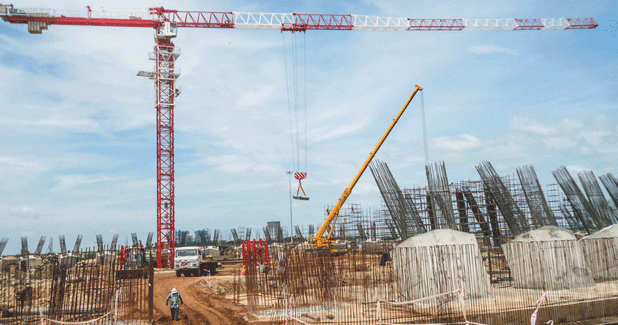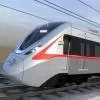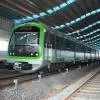- Home
- Technology
- Bigger is Better

Bigger is Better
The past few years have been challenging for the crane industry. While industry voices affirm that a turnaround has begun, the consensus seems to be that overall growth will be muted in the near term.
¨Demand for cranes has been on the decline for the past three years,¨ says Manoj Agarwal, Head-Material Handling Business, Escorts- Construction Equipment Ltd. ¨Now with growing expectations of construction activity gaining momentum, we feel the worst is behind us and growth should ensue. However, double-digit growth is still some distance away; we expect that only in the next fiscal,¨ he adds. ¨Our outlook on the crane sector is positive yet conservative,¨ opines Sumit Biswas, General Manager-Sales & Marketing, Material Handling Solutions, TIL Ltd. ¨We are not projecting sharp double-digit growth in the immediate and short term as many major projects are stuck in the process of land acquisition. We expect some growth after allocated coal blocks start mining.¨
And Ajay Kumar Somani, Director-Mobile Crane Division, Liebherr India Pvt Ltd, says, ¨Growth in 2015 is almost a fifth higher than last year. We expect it to increase in 2016.¨ Some segments in the crane industry are performing better than others. TechNavio analysts forecast the pick-n-carry crane market in India, the dominant crane segment, to grow at a CAGR of 18.5 per cent over 2014 to 2019.
According to Tushar Mehendale, Managing Director, ElectroMech, ¨Tower crane demand could grow at 20 per cent per annum driven by high-rise property development in metros and in Tier-II and Tier-III cities.¨
Crane rentals have also been dismal with rental players still struggling to recover dues of the past couple of years from contractors and other end-users, according to Ashwin Gandhi, President, Crane Owners Association of India. ¨Service tax has also imposed an extra burden on crane owners,¨ he says. ¨Demand for cranes on rent has stayed the same since the new government took over last year. Actually, investments in infrastructure have started only after this year´s Budget. We hope these will boost demand for cranes and kick-start projects.¨
Top sellers
Traditionally, pick-n-carry cranes have dominated the Indian crane market in terms of volume. Today, however, demand for other kind of cranes is growing, thus creating new opportunities.
¨In our product portfolio spanning pick-n-carry cranes up to 23 tonne capacity, rough terrain slew cranes up to 40 tonne capacity and truck-mounted cranes, the most popular are 14 tonne pick-n-carry cranes, 40 tonne slew cranes and 70 to 80 tonne truck-mounted cranes,¨ says Agarwal.
Two types of cranes are in good demand, opines Somani; Crawler cranes of 600 tonne capacity and tyre-mounted, all-terrain cranes of 200 tonne capacity. ¨Demand for crawler cranes is mainly from the windmill power generation sector,¨ he explains. ¨And demand for tyre-mounted cranes is from end users, mainly cement plants, where 200 tonne, all-terrain cranes are useful for day-to-day maintenance jobs and come in handy even when the plant is shut down.¨
¨Truck cranes of 40 to 75 tonne capacity are most in demand these days,¨ states Biswas. ¨We are at the forefront of the rough terrain crane market, where 40 tonne cranes are the most popular owing to their versatility and compactness.¨
¨Manitowoc´s bestselling tower crane in India is the Potain MCi 85 while the Grove GMK6300L 300 tonne is currently one of the most popular Grove all-terrain mobile cranes in the country for commanding a large lifting capacity while maintaining its versatility and compact design,¨ says Raman Joshi, Managing Director, Manitowoc Cranes India. Seeing the success of the Potain, the company has recently launched the topless Potain tower crane model MCT 205 with 10 tonne maximum capacity and the topless Potain model MCT 85 with 5 tonne maximum capacity.
¨Gantry cranes of capacity varying between 50 mt and 180 mt are in demand for precast yards, tunnelling and bridge-building projects,¨ he adds. ¨Tower cranes of 5 tonne capacity are in demand for real estate projects using standard construction methods while those of 8 to 20 tonne capacity are being sought for precast construction,¨ shares Mehendale. ¨In the past few years, the foremost contributors to our growth have been the infrastructure, construction and automotive (both OEMs and auto ancillary suppliers) sectors.¨
The ´big´ trend A notable industry trend is growing demand for high-capacity cranes. Industry voices second this opinion. ¨In India, and around the world, projects are looking for stronger cranes with an even better reach,¨ says Joshi. ¨This applies to all kinds of industry sectors, such as construction, oil and gas, petrochemical plants, etc.¨
Changing construction methods are a key driver of this trend. ¨Growing adoption of prefab modular structure construction technology, for infrastructure such as metro rails, flyovers and bridges, as well as to some extent, buildings, is growing the need for high-capacity cranes,¨ says Biswas. ¨Crane hirers are also looking for higher capacity cranes, starting from 40 tonne.¨
¨Greater use of precast girders in bridges, elevated roads and other projects is driving demand for cranes capable of handling heavier loads and with longer reaches,¨ adds Somani.
¨In the real estate construction sector, we are seeing a definite shift towards higher capacity tower cranes as construction technologies such as precast become more popular,¨ says Mehendale.
After construction, cranes can still have a role to play in the placement of equipment in newly built factories and plants. Here, it was the custom to separately lift many items for assembly and fix them at height. Whereas Somani notes the current trend is to assemble items as much as possible at ground, and then lift the assemblies for fixing. ¨While this saves time and results in better quality, it has increased the crane capacity requirement,¨ he says.
As the size of heavy equipment being assembled and commissioned in infrastructure projects becomes bigger, higher capacity cranes are needed for handling such equipment. For instance, coal mining companies used to prefer cranes of 20 tonne and 30 tonne capacity, but now demand has shifted to cranes with a capacity of 40 tonne and above, shares Biswas.
Among the leading industries needing higher capacity cranes are refineries, windmills, steel plants and thermal power plants. ¨Infrastructure, power and heavy engineering typically demand higher capacity tower cranes,¨ says Mehendale. Notably, development in these sectors is driving demand for cranes of even higher capacity. ¨Bigger and taller windmill towers have shifted demand from the 350 to 400 tonne class of crawler crane to the 600 tonne class,¨ observes Somani. ¨Power plants, bigger in size and capacity than their predecessors, are being created.¨
Another driver of higher capacity cranes is a growing concern for safety, according to Agarwal. ¨All the agencies involved in construction are focusing on avoiding any fatal accidents, for which it makes sense to use higher capacity cranes that are better equipped for any kind of lifting job,¨ he explains.
TechNavio expects higher capacity pick-n-carry cranes to become increasingly prominent in the Indian market because of the rise in requirements like handling heavy loads, longer reaches and tough ground conditions. ¨While this segment is dominated by cranes with 15 tonne capacity, sectors like infrastructure, industry and manufacturing are expected to increase the demand for higher capacity cranes, primarily at their factory warehouses for stocking and moving goods,¨ says Faisal Ghaus, Vice President, TechNavio.
Gaps in availability
Demand for cranes of bigger capacity bodes well for larger crane rental players. ¨Larger players have an edge over medium and small crane owners as higher capacity cranes (beyond 200 mt) owned by mostly large players earn 10-15 per cent more rent,¨ says Gandhi.
It also creates opportunities for crane vendors. In keeping with the bigger-is-better trend, Liebherr India has launched an upgraded version of the 750 tonne crawler crane with almost 20 per cent increase in capacity, LR 1750/2. It has also launched the LR 1500 crawler crane with capacity of 500 tonne. And, a 250 tonne, all-terrain, tyre-mounted crane, LTM 1250-5,1, features five axles vis-a-vis the earlier model with six axles.
Such launches are much needed for the industry given the glaring gaps in the availability of big cranes.
¨At present, hardly 10 to 15 tyre-mounted telescopic cranes of 500 mt capacity exist in the rental industry across India,¨ notes Praveen Sharma, Managing Director, ABC Infra Equipment Pvt Ltd. ¨In view of upcoming projects, there is bound to be short supply for telescopic cranes of capacity over 500 mt. We have seen many instances when work has to be carried out manually because such high capacity cranes aren´t available.¨
¨Heavy-duty crawler cranes (of capacity 500 mt and above) are also in limited supply,¨ observes Sharma. ¨Most existing machines are in use.¨
Clearly, the Indian market needs more heavy-duty cranes.
To go with this, the industry also needs more skilled service engineers capable of trouble-shooting these cranes. ¨Too few such engineers exist today,¨ adds Sharma. ¨So there is substantial opportunity in the crane service sector in the years to come.¨ A positive sign, that.
Quick Bytes
- Pick and carry crane segment to grow at a CAGR of 18.5% over 2014-19.
- Power plants, coal mining, refineries, windmills, steel and thermal power plants need bigger and higher capacity cranes.
- In demand: Crawler cranes of 600 tonne capacity and tyre-mounted, all-terrain cranes of 200 tonne capacity.
- Crane Industry
- Manoj Agarwal
- Escorts- Construction Equipment Ltd
- Sumit Biswas
- TIL Ltd
- Ajay Kumar Somani
- Liebherr India Pvt Ltd
- Tushar Mehendale
- ElectroMech
- Ashwin Gandhi
- Crane Owners Association of India
- Infrastructure
- Somani
- Manitowoc Cranes India
- Raman Joshi
- Potain
- Faisal Ghaus
- TechNavio
- Praveen Sharma
- ABC Infra Equipment Pvt Ltd
Size really does matter for the crane industry, which is gradually scaling new heights. The past few years have been challenging for the crane industry. While industry voices affirm that a turnaround has begun, the consensus seems to be that overall growth will be muted in the near term. ¨Demand for cranes has been on the decline for the past three years,¨ says Manoj Agarwal, Head-Material Handling Business, Escorts- Construction Equipment Ltd. ¨Now with growing expectations of construction activity gaining momentum, we feel the worst is behind us and growth should ensue. However, double-digit growth is still some distance away; we expect that only in the next fiscal,¨ he adds. ¨Our outlook on the crane sector is positive yet conservative,¨ opines Sumit Biswas, General Manager-Sales & Marketing, Material Handling Solutions, TIL Ltd. ¨We are not projecting sharp double-digit growth in the immediate and short term as many major projects are stuck in the process of land acquisition. We expect some growth after allocated coal blocks start mining.¨ And Ajay Kumar Somani, Director-Mobile Crane Division, Liebherr India Pvt Ltd, says, ¨Growth in 2015 is almost a fifth higher than last year. We expect it to increase in 2016.¨ Some segments in the crane industry are performing better than others. TechNavio analysts forecast the pick-n-carry crane market in India, the dominant crane segment, to grow at a CAGR of 18.5 per cent over 2014 to 2019. According to Tushar Mehendale, Managing Director, ElectroMech, ¨Tower crane demand could grow at 20 per cent per annum driven by high-rise property development in metros and in Tier-II and Tier-III cities.¨ Crane rentals have also been dismal with rental players still struggling to recover dues of the past couple of years from contractors and other end-users, according to Ashwin Gandhi, President, Crane Owners Association of India. ¨Service tax has also imposed an extra burden on crane owners,¨ he says. ¨Demand for cranes on rent has stayed the same since the new government took over last year. Actually, investments in infrastructure have started only after this year´s Budget. We hope these will boost demand for cranes and kick-start projects.¨ Top sellers Traditionally, pick-n-carry cranes have dominated the Indian crane market in terms of volume. Today, however, demand for other kind of cranes is growing, thus creating new opportunities. ¨In our product portfolio spanning pick-n-carry cranes up to 23 tonne capacity, rough terrain slew cranes up to 40 tonne capacity and truck-mounted cranes, the most popular are 14 tonne pick-n-carry cranes, 40 tonne slew cranes and 70 to 80 tonne truck-mounted cranes,¨ says Agarwal. Two types of cranes are in good demand, opines Somani; Crawler cranes of 600 tonne capacity and tyre-mounted, all-terrain cranes of 200 tonne capacity. ¨Demand for crawler cranes is mainly from the windmill power generation sector,¨ he explains. ¨And demand for tyre-mounted cranes is from end users, mainly cement plants, where 200 tonne, all-terrain cranes are useful for day-to-day maintenance jobs and come in handy even when the plant is shut down.¨ ¨Truck cranes of 40 to 75 tonne capacity are most in demand these days,¨ states Biswas. ¨We are at the forefront of the rough terrain crane market, where 40 tonne cranes are the most popular owing to their versatility and compactness.¨ ¨Manitowoc´s bestselling tower crane in India is the Potain MCi 85 while the Grove GMK6300L 300 tonne is currently one of the most popular Grove all-terrain mobile cranes in the country for commanding a large lifting capacity while maintaining its versatility and compact design,¨ says Raman Joshi, Managing Director, Manitowoc Cranes India. Seeing the success of the Potain, the company has recently launched the topless Potain tower crane model MCT 205 with 10 tonne maximum capacity and the topless Potain model MCT 85 with 5 tonne maximum capacity. ¨Gantry cranes of capacity varying between 50 mt and 180 mt are in demand for precast yards, tunnelling and bridge-building projects,¨ he adds. ¨Tower cranes of 5 tonne capacity are in demand for real estate projects using standard construction methods while those of 8 to 20 tonne capacity are being sought for precast construction,¨ shares Mehendale. ¨In the past few years, the foremost contributors to our growth have been the infrastructure, construction and automotive (both OEMs and auto ancillary suppliers) sectors.¨ The ´big´ trend A notable industry trend is growing demand for high-capacity cranes. Industry voices second this opinion. ¨In India, and around the world, projects are looking for stronger cranes with an even better reach,¨ says Joshi. ¨This applies to all kinds of industry sectors, such as construction, oil and gas, petrochemical plants, etc.¨ Changing construction methods are a key driver of this trend. ¨Growing adoption of prefab modular structure construction technology, for infrastructure such as metro rails, flyovers and bridges, as well as to some extent, buildings, is growing the need for high-capacity cranes,¨ says Biswas. ¨Crane hirers are also looking for higher capacity cranes, starting from 40 tonne.¨ ¨Greater use of precast girders in bridges, elevated roads and other projects is driving demand for cranes capable of handling heavier loads and with longer reaches,¨ adds Somani. ¨In the real estate construction sector, we are seeing a definite shift towards higher capacity tower cranes as construction technologies such as precast become more popular,¨ says Mehendale. After construction, cranes can still have a role to play in the placement of equipment in newly built factories and plants. Here, it was the custom to separately lift many items for assembly and fix them at height. Whereas Somani notes the current trend is to assemble items as much as possible at ground, and then lift the assemblies for fixing. ¨While this saves time and results in better quality, it has increased the crane capacity requirement,¨ he says. As the size of heavy equipment being assembled and commissioned in infrastructure projects becomes bigger, higher capacity cranes are needed for handling such equipment. For instance, coal mining companies used to prefer cranes of 20 tonne and 30 tonne capacity, but now demand has shifted to cranes with a capacity of 40 tonne and above, shares Biswas. Among the leading industries needing higher capacity cranes are refineries, windmills, steel plants and thermal power plants. ¨Infrastructure, power and heavy engineering typically demand higher capacity tower cranes,¨ says Mehendale. Notably, development in these sectors is driving demand for cranes of even higher capacity. ¨Bigger and taller windmill towers have shifted demand from the 350 to 400 tonne class of crawler crane to the 600 tonne class,¨ observes Somani. ¨Power plants, bigger in size and capacity than their predecessors, are being created.¨ Another driver of higher capacity cranes is a growing concern for safety, according to Agarwal. ¨All the agencies involved in construction are focusing on avoiding any fatal accidents, for which it makes sense to use higher capacity cranes that are better equipped for any kind of lifting job,¨ he explains. TechNavio expects higher capacity pick-n-carry cranes to become increasingly prominent in the Indian market because of the rise in requirements like handling heavy loads, longer reaches and tough ground conditions. ¨While this segment is dominated by cranes with 15 tonne capacity, sectors like infrastructure, industry and manufacturing are expected to increase the demand for higher capacity cranes, primarily at their factory warehouses for stocking and moving goods,¨ says Faisal Ghaus, Vice President, TechNavio. Gaps in availability Demand for cranes of bigger capacity bodes well for larger crane rental players. ¨Larger players have an edge over medium and small crane owners as higher capacity cranes (beyond 200 mt) owned by mostly large players earn 10-15 per cent more rent,¨ says Gandhi. It also creates opportunities for crane vendors. In keeping with the bigger-is-better trend, Liebherr India has launched an upgraded version of the 750 tonne crawler crane with almost 20 per cent increase in capacity, LR 1750/2. It has also launched the LR 1500 crawler crane with capacity of 500 tonne. And, a 250 tonne, all-terrain, tyre-mounted crane, LTM 1250-5,1, features five axles vis-a-vis the earlier model with six axles. Such launches are much needed for the industry given the glaring gaps in the availability of big cranes. ¨At present, hardly 10 to 15 tyre-mounted telescopic cranes of 500 mt capacity exist in the rental industry across India,¨ notes Praveen Sharma, Managing Director, ABC Infra Equipment Pvt Ltd. ¨In view of upcoming projects, there is bound to be short supply for telescopic cranes of capacity over 500 mt. We have seen many instances when work has to be carried out manually because such high capacity cranes aren´t available.¨ ¨Heavy-duty crawler cranes (of capacity 500 mt and above) are also in limited supply,¨ observes Sharma. ¨Most existing machines are in use.¨ Clearly, the Indian market needs more heavy-duty cranes. To go with this, the industry also needs more skilled service engineers capable of trouble-shooting these cranes. ¨Too few such engineers exist today,¨ adds Sharma. ¨So there is substantial opportunity in the crane service sector in the years to come.¨ A positive sign, that. Quick Bytes Pick and carry crane segment to grow at a CAGR of 18.5% over 2014-19. Power plants, coal mining, refineries, windmills, steel and thermal power plants need bigger and higher capacity cranes. In demand: Crawler cranes of 600 tonne capacity and tyre-mounted, all-terrain cranes of 200 tonne capacity.



















